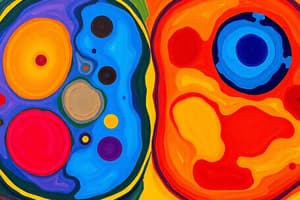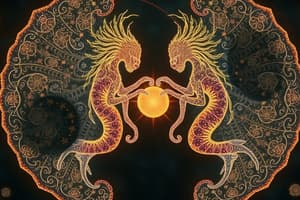Podcast
Questions and Answers
Which of the following processes is exclusive to eukaryotic cell division and not found in prokaryotic cell division?
Which of the following processes is exclusive to eukaryotic cell division and not found in prokaryotic cell division?
- Cytokinesis
- Cell growth
- DNA replication
- Mitosis/Meiosis (correct)
The primary function of the Golgi apparatus is energy production through cellular respiration.
The primary function of the Golgi apparatus is energy production through cellular respiration.
False (B)
Briefly explain the significance of the nuclear envelope's pores in the context of cellular function.
Briefly explain the significance of the nuclear envelope's pores in the context of cellular function.
Nuclear pores regulate the transport of molecules (e.g., mRNA, proteins) between the nucleus and cytoplasm, which is essential for gene expression and cellular communication.
During cytokinesis in animal cells, a ______ forms to divide the cytoplasm, whereas in plant cells, a ______ forms.
During cytokinesis in animal cells, a ______ forms to divide the cytoplasm, whereas in plant cells, a ______ forms.
Match the cell organelle with its primary function:
Match the cell organelle with its primary function:
Which component of the cytoskeleton is primarily involved in muscle contraction and cell movement?
Which component of the cytoskeleton is primarily involved in muscle contraction and cell movement?
Peroxisomes are primarily responsible for synthesizing proteins within the cell.
Peroxisomes are primarily responsible for synthesizing proteins within the cell.
Explain the role of the smooth endoplasmic reticulum (SER) in detoxification processes.
Explain the role of the smooth endoplasmic reticulum (SER) in detoxification processes.
The ______ is a structure within the nucleus responsible for ribosome synthesis.
The ______ is a structure within the nucleus responsible for ribosome synthesis.
Match the following terms with their descriptions related to the cell membrane:
Match the following terms with their descriptions related to the cell membrane:
What is the main purpose of the cristae in mitochondria?
What is the main purpose of the cristae in mitochondria?
The cell wall, present in animal cells, provides rigid support and protection.
The cell wall, present in animal cells, provides rigid support and protection.
Describe the process of autophagy and its significance in cellular health.
Describe the process of autophagy and its significance in cellular health.
During mitosis, ______ organize the mitotic spindle which is essential for chromosome segregation.
During mitosis, ______ organize the mitotic spindle which is essential for chromosome segregation.
Match the cell cycle phase with its primary event:
Match the cell cycle phase with its primary event:
Which of the following organelles is responsible for photosynthesis in plant cells?
Which of the following organelles is responsible for photosynthesis in plant cells?
Meiosis results in two identical daughter cells, similar to mitosis.
Meiosis results in two identical daughter cells, similar to mitosis.
What is the significance of vacuoles, particularly in plant cells?
What is the significance of vacuoles, particularly in plant cells?
The cell membrane is composed of a ______ bilayer with embedded ______.
The cell membrane is composed of a ______ bilayer with embedded ______.
Match the cell structure with its definition:
Match the cell structure with its definition:
Flashcards
Cell Biology
Cell Biology
Study of cells, their structure, function, and behavior, including interactions and environment.
Cell Division
Cell Division
Process where a parent cell divides into two or more daughter cells.
Mitosis
Mitosis
Cell division of somatic cells into two identical daughter cells. Crucial for growth and repair.
Meiosis
Meiosis
Signup and view all the flashcards
Binary Fission
Binary Fission
Signup and view all the flashcards
Cell Cycle
Cell Cycle
Signup and view all the flashcards
Cytokinesis
Cytokinesis
Signup and view all the flashcards
Cell Organelles
Cell Organelles
Signup and view all the flashcards
Nucleus
Nucleus
Signup and view all the flashcards
Mitochondria
Mitochondria
Signup and view all the flashcards
Endoplasmic Reticulum (ER)
Endoplasmic Reticulum (ER)
Signup and view all the flashcards
Golgi Apparatus
Golgi Apparatus
Signup and view all the flashcards
Lysosomes
Lysosomes
Signup and view all the flashcards
Peroxisomes
Peroxisomes
Signup and view all the flashcards
Ribosomes
Ribosomes
Signup and view all the flashcards
Cytoskeleton
Cytoskeleton
Signup and view all the flashcards
Vacuoles
Vacuoles
Signup and view all the flashcards
Chloroplasts
Chloroplasts
Signup and view all the flashcards
Cell Membrane
Cell Membrane
Signup and view all the flashcards
Cell Wall
Cell Wall
Signup and view all the flashcards
Study Notes
- Cell biology is the study of cells, their structure, function, and behavior.
- It encompasses the physiological properties of cells, their interactions, and their environment.
- Cell biology examines both prokaryotic and eukaryotic cells.
- Research in cell biology is related to other fields such as genetics, molecular biology, and biochemistry.
- Understanding cell biology is vital for comprehending tissues, organs, and the overall functioning of living organisms.
Cell Division
- Cell division is the process by which a parent cell divides into two or more daughter cells.
- In eukaryotes, there are two main types of cell division: mitosis and meiosis.
- Mitosis is the division of a somatic cell into two identical daughter cells, crucial for growth, repair, and asexual reproduction.
- Meiosis is the division of a germ cell into four genetically different daughter cells, essential for sexual reproduction, creating gametes (sperm and egg cells).
- In prokaryotes, cell division occurs through binary fission, a simpler process than eukaryotic mitosis or meiosis.
- The cell cycle includes interphase, where the cell grows and replicates its DNA, followed by the mitotic phase (mitosis and cytokinesis) or meiosis.
- Regulation of the cell cycle is critical; disruptions can lead to uncontrolled cell division and diseases like cancer.
- Cytokinesis is the physical process of cell division, where the cytoplasm of a single eukaryotic cell divides to form two daughter cells.
- In animal cells, cytokinesis involves the formation of a cleavage furrow, while in plant cells, a cell plate forms.
Cell Organelles
- Cell organelles are specialized subunits within a cell that perform specific functions.
- They are membrane-bound structures in eukaryotic cells.
- Major cell organelles include the nucleus, mitochondria, endoplasmic reticulum, Golgi apparatus, lysosomes, and peroxisomes.
- The nucleus contains the cell's genetic material (DNA) and controls the cell's growth and reproduction.
- Mitochondria are responsible for generating energy through cellular respiration, producing ATP.
- The endoplasmic reticulum (ER) is involved in protein synthesis, folding, and lipid synthesis; it exists in two forms: rough ER (with ribosomes) and smooth ER (without ribosomes).
- The Golgi apparatus processes and packages proteins and lipids synthesized in the ER, directing them to their final destinations.
- Lysosomes contain enzymes that break down cellular waste and debris, as well as ingested substances.
- Peroxisomes are involved in detoxification and lipid metabolism.
- Ribosomes, though not membrane-bound, are essential for protein synthesis; they can be found free in the cytoplasm or attached to the ER.
- The cytoskeleton provides structural support and facilitates cell movement; it includes microtubules, intermediate filaments, and microfilaments.
- Centrioles are involved in cell division in animal cells, organizing the mitotic spindle.
- Vacuoles store water, nutrients, and waste products; they are particularly large in plant cells, helping maintain turgor pressure.
- Chloroplasts (in plant cells) conduct photosynthesis, converting light energy into chemical energy.
- The cell membrane (plasma membrane) is a selectively permeable barrier that controls the movement of substances into and out of the cell.
- The cell wall (in plant, bacteria, fungi) provides additional support and protection.
Nucleus
- The nucleus houses the cell's DNA, organized into chromosomes.
- It is surrounded by a double membrane called the nuclear envelope.
- The nuclear envelope contains pores that regulate the passage of molecules between the nucleus and cytoplasm.
- The nucleolus, located within the nucleus, is the site of ribosome synthesis.
- The nucleus controls cell growth, metabolism, and reproduction.
Mitochondria
- Mitochondria are the powerhouses of the cell, producing ATP through cellular respiration.
- They have a double membrane structure: an outer membrane and a highly folded inner membrane (cristae).
- The cristae increase the surface area for ATP production.
- The mitochondrial matrix contains enzymes, DNA, and ribosomes.
- Mitochondria have their own DNA, suggesting an endosymbiotic origin.
Endoplasmic Reticulum (ER)
- The ER is a network of membranes involved in protein and lipid synthesis.
- Rough ER (RER) is studded with ribosomes and is involved in protein synthesis and modification.
- Smooth ER (SER) lacks ribosomes and is involved in lipid synthesis, detoxification, and calcium storage.
- The ER plays a role in transporting molecules within the cell.
Golgi Apparatus
- The Golgi apparatus processes and packages proteins and lipids.
- It consists of flattened sacs called cisternae.
- Proteins and lipids from the ER pass through the Golgi, where they are modified, sorted, and packaged into vesicles.
- Vesicles transport these molecules to their final destinations, such as the cell membrane or lysosomes.
Lysosomes
- Lysosomes contain hydrolytic enzymes that break down cellular waste and debris.
- They are involved in autophagy (the breakdown of cellular components) and phagocytosis (the engulfment of external particles).
- Lysosomes help maintain cellular cleanliness and recycle cellular components.
Peroxisomes
- Peroxisomes contain enzymes that detoxify harmful substances and metabolize lipids.
- They break down fatty acids and produce hydrogen peroxide as a byproduct, which is then converted into water and oxygen.
- Peroxisomes are important in liver and kidney cells.
Cytoskeleton
- The cytoskeleton is a network of protein filaments that provides structural support and facilitates cell movement.
- It includes microtubules, intermediate filaments, and microfilaments.
- Microtubules are hollow tubes that provide tracks for intracellular transport.
- Intermediate filaments provide mechanical strength and support.
- Microfilaments (actin filaments) are involved in cell movement and muscle contraction.
Cell Membrane
- The cell membrane (plasma membrane) surrounds the cell and controls the movement of substances into and out of the cell.
- It is composed of a phospholipid bilayer with embedded proteins.
- The phospholipid bilayer is selectively permeable, allowing some molecules to pass through while blocking others.
- Membrane proteins perform various functions, such as transporting molecules, acting as receptors, and facilitating cell adhesion.
Studying That Suits You
Use AI to generate personalized quizzes and flashcards to suit your learning preferences.




